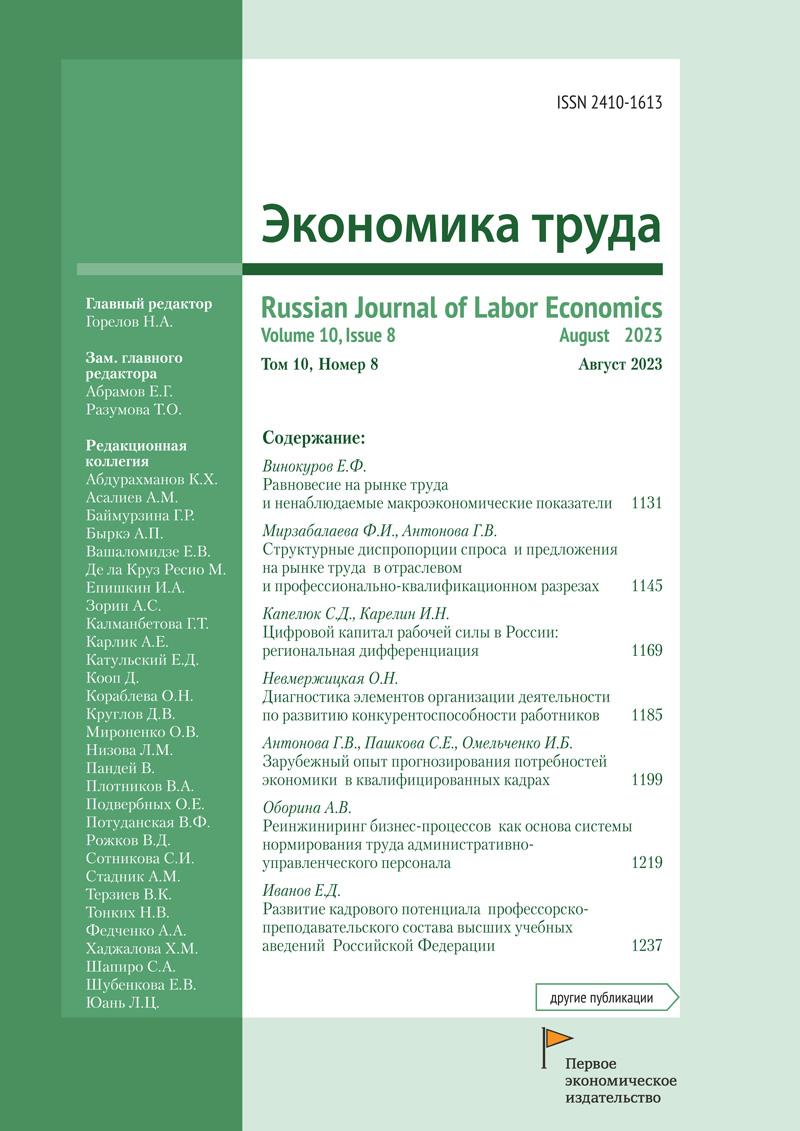Structural imbalances in labor market supply and demand at the sectoral and occupational qualification levels
- 作者: Mirzabalaeva F.I.1,2, Antonova G.V.2
-
隶属关系:
- Plekhanov Russian University of Economics
- All-Russian Research Institute of Labour of the Ministry of Labour and Social Protection of the Russian Federation
- 期: 卷 10, 编号 8 (2023)
- 页面: 1145-1168
- 栏目: Articles
- URL: https://journals.eco-vector.com/2410-1613/article/view/607811
- DOI: https://doi.org/10.18334/et.10.8.118938
- ID: 607811
如何引用文章
详细
The qualitative and quantitative mismatch between labor supply and demand has a significant impact on labor shortages and the growth of structural unemployment in the labor market. Under the pressure of sanctions, increasing brain drain and mobilization of part of the able-bodied population, the problems of matching labor demand and supply in Russia are becoming particularly acute. Solving these problems is the primary way to address the staffing shortage. The unbalanced situation in the labor market is aggravated not only by the current problems, but also by new risks in the future, complicating the effectiveness of the national labor market and the declining possibilities of its state regulation, preventing effective restructuring of employment, increasing productivity and quality of labor. The study of employers' needs for qualified personnel is a necessary tool for determining measures for the economic development of the country, for the development and implementation of state policy to ensure the balance of the labor market, and for the modernization of the vocational education system.The authors focused on the factors affecting the supply and demand of labor. The analysis of the formed industry and professional qualification imbalances in the Russian labor market is carried out. The results of the study can be used by the relevant public authorities in improving the legal framework for regulating structural imbalances in the labor market, as well as for research and educational purposes.
作者简介
Farida Mirzabalaeva
Plekhanov Russian University of Economics; All-Russian Research Institute of Labour of the Ministry of Labour and Social Protection of the Russian Federation
Email: faridamir@yandex.ru
Galina Antonova
All-Russian Research Institute of Labour of the Ministry of Labour and Social Protection of the Russian Federation
Email: ant-gal@yandex.ru
参考
- Белова Л.Г. Технологическая безработица и бизнес-модель шеринговой экономики в условиях цифровизации экономики // Вестник Московского университета. Серия 6: Экономика. – 2021. – № 1. – c. 208-225.
- Ведомственная статистка Роструда Форма 2-Т «Трудоустройство»
- Демографический прогноз до 2035 года. Численность населения по отдельным возрастным группам. Росстат. [Электронный ресурс]. URL: https://rosstat.gov.ru/folder/12781 (дата обращения: 11.08.2023).
- Итоги выборочного обследования рабочей силы. Ежеквартальный статистический бюллетень. [Электронный ресурс]. URL: https://rosstat.gov.ru/compendium/document/13265.
- Коровкин А.Г. Макроэкономическая оценка состояния и перспектив развития сферы занятости и рынка труда в России // Журнал новой экономической ассоциации. – 2018. – № 1(37). – c. 168-176. – doi: 10.31737/2221-2264-2018-37-1-7.
- Коровкин А.Г., Долгова И.Н., Королев И.Б., Андрюнин А.В., Единак Е.А. Макроэкономическая оценка состояния сферы занятости и рынка труда в России 2010—2025 годов. - М.: МАКС Пресс, 2011. – 84 c.
- Коропец О.А., Тухтарова Е.Х. Влияние передовых технологий индустрии 4.0 на безработицу в российских регионах // Экономика региона. – 2021. – № 1. – c. 182-196. – doi: 10.17059/ekon.reg.2021-1-14.
- Кочетов А.Н., Бурлиту-Лажони С. Занижение цены труда и устойчивость структурной безработицы в России // Вестник Поволжского института управления. – 2018. – № 3. – c. 74-81. – doi: 10.22394/1682-2358-2018-3-74-81.
- Лукьянова А.Л., Капелюшников Р.И. Работники предпенсионного и пенсионного возраста на российском рынке труда: тенденции в реаллокации занятости // Вопросы экономики. – 2019. – № 11. – c. 5-34. – doi: 10.32609/0042-8736-2019-11-5-34.
- Рынок труда в новых экономических условиях. Центр стратегических разработок. [Электронный ресурс]. URL: https://www.csr.ru/ru/research/rynok-truda-v-novykh-ekonomicheskikh-usloviyakh/ (дата обращения: 10.08.2023).
- Симонова М.В., Санкова Л.В., Мирзабалаева Ф.И. Стратегическое планирование кадрового обеспечения социально-значимых отраслей экономики регионов // Креативная экономика. – 2023. – № 8. – doi: 10.18334/ce.17.8.118792.
- Смирнов С.Н., Капустин А.К. Оценка структурных разрывов между спросом и предложением на рынках труда регионов Российской Федерации // Вопросы статистики. – 2018. – № 10. – c. 28-36.
- Чекмарев О.П., Ильвес А.Л., Конев П.А. Потенциал занятости и безработицы в России в условиях санкций 2022 года // Экономика труда. – 2022. – № 4. – c. 765-780. – doi: 10.18334/et.9.4.114599.
- Федеральное статистическое наблюдение «Сведения о численности и потребности организаций в работниках по профессиональным группам». Rosstat.gov.ru. [Электронный ресурс]. URL: https://rosstat.gov.ru/compendium/document/13266 (дата обращения: 12.08.2023).
- The green employment and skills transformation: Insights from a European Green Deal skills forecast scenario. Cedefop. [Электронный ресурс]. URL: https://www.cedefop.europa.eu/files/4206_en.pdf (дата обращения: 02.08.2023).
- Report on labour shortages and surpluses. European Labour Authority. [Электронный ресурс]. URL: https://www.ela.europa.eu/sites/default/files/2021-12/2021%20Labour%20shortages%20%20surpluses%20report.pdf (дата обращения: 02.08.2023).
- Eurofound Changing labour markets – How to prevent a mismatch between skills and jobs in times of transition – Background paper. Eurofound, Dublin. [Электронный ресурс]. URL: https://www.eurofound.europa.eu/publications/blog/eu-lack-of-labour-wont-be-solved-by-skills-alone-improving-job-quality-is-key (дата обращения: 04.08.2023).
- Eurofound Impact of the transition to a carbon-neutral economy on employment and its effect on overall job quality. - Luxembourg: Publications Office of the European Union, 2023.
- Eurofound Measures to tackle labour shortages: Lessons for future policy. Publications Office of the European Union. [Электронный ресурс]. URL: https://www.eurofound.europa.eu/publications/report/2023/measures-to-tackle-labour-shortages-lessons-for-future-policy (дата обращения: 05.08.2023).
- Eurofound and Cedefop Workplace practices unlocking employee potential, European Company Survey 2019. - Luxembourg: Publications Office of the European Union, 2020.
- European Commission Communication from the Commission to the European Parliament, the Council, the European Economic and Social Committee and the Committee of the Regions: A renovation wave for Europe – Greening our buildings, creating jobs, improving lives, COM (2020) 662 final. , 2020.
- 2030 digital compass: The European way for the digital decade. European Commission. [Электронный ресурс]. URL: https://www.fintechnews.org/2030-digital-compass-the-european-way-for-the-digital-decade/.
- Marin G., Vona F. Climate policies, skill-biased employment dynamics: Evidence from EU countries // Journal of Environmental Economics and Management. – 2019. – p. 102253. – doi: 10.1016/j.jeem.2019.102253.
- OECD Job creation and local economic development 2023: Bridging the great green divide. - Paris: OECD Publishing, 2023. – 167 p.
补充文件








